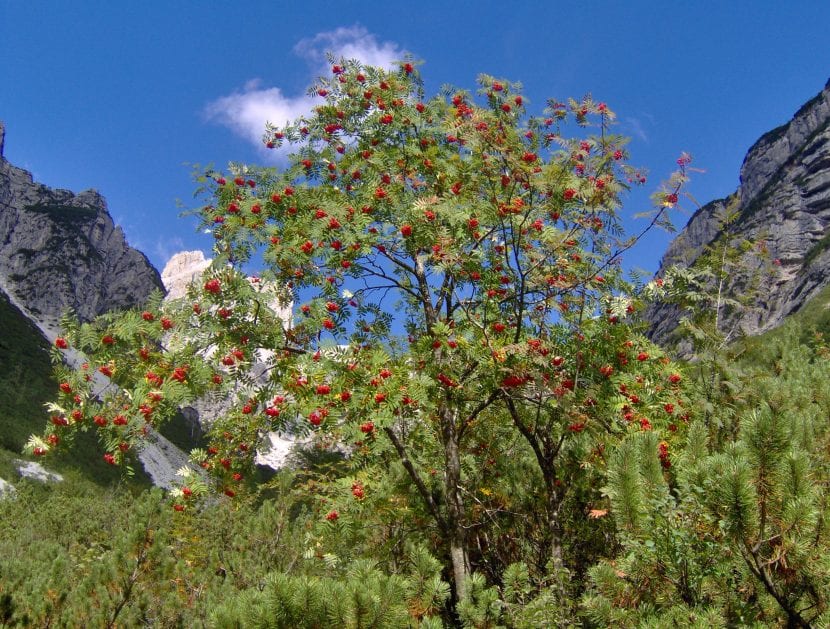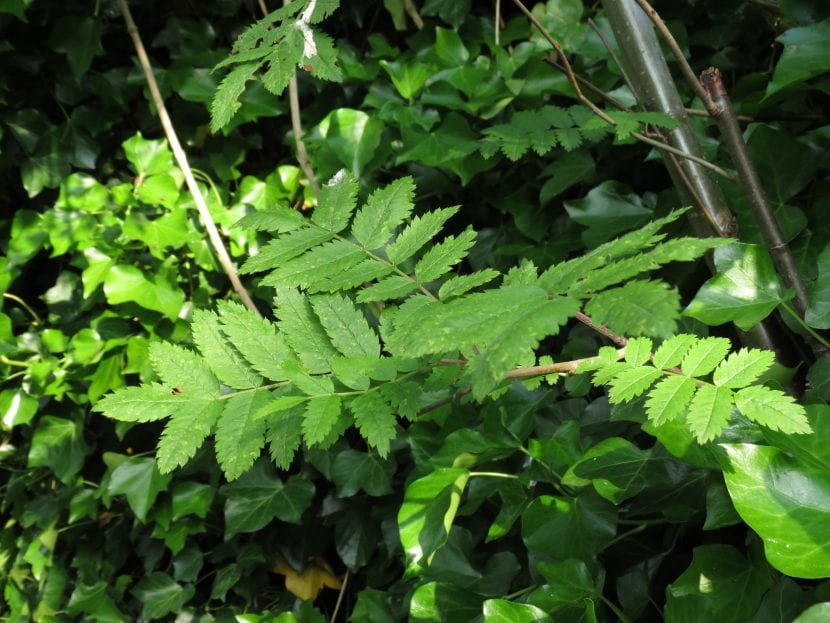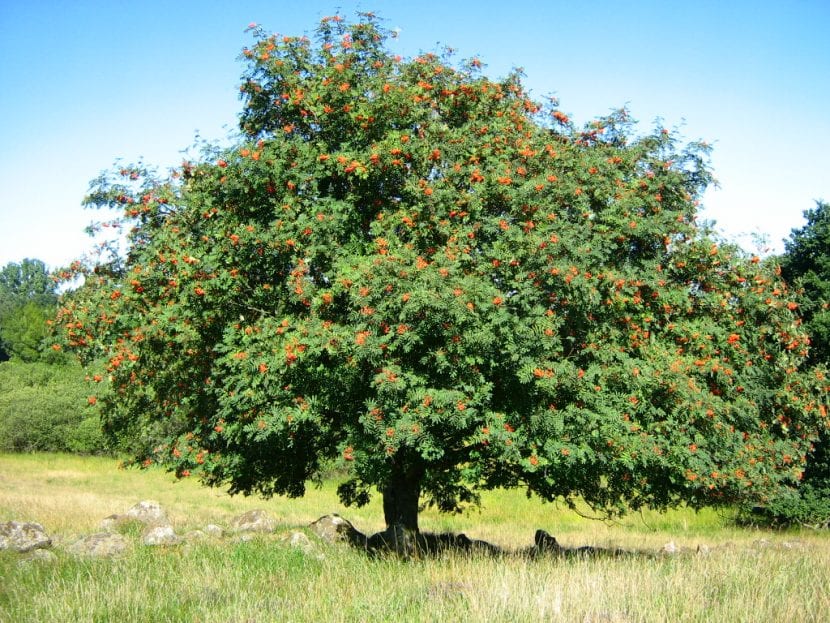
The Hunters' Rowan, a tree that receives the scientific name of sorbus aucuparia, It is one of the most suitable to have in gardens in temperate-cold climates. What's more, gives an excellent shade, so much so that under its branches you can hold picnics and invite the whole family 😉.
Its flowers are also noteworthy. Although they are small and simple, they appear in such quantity and are so pretty, that it is a pleasure to see them. Do you want to know more about this plant?
Origin and characteristics of sorbus aucuparia
Our protagonist It is a deciduous tree native to Europe, from Iceland to Russia, passing through the Iberian Peninsula, Asia and northeast Africa. It grows in fir, beech and oak forests. In addition to being the hunters' Rowan, it is also commonly called as wild rowan, bird-watchers, azarollo or capudre.
It is characterized by reaching a height of between 15 and 20 meters. Its crown is very wide, reaching about 5-6 meters, and is made up of leaves that are arranged alternately along the stems. These are compound, odd-pinnate, oblong, and with serrated edges.
The flowers are grouped in terminal corymb-shaped inflorescences of 8 to 15cm in diameter with more than 250 white flowers. Once they are fertilized, the fruit begins to ripen, which will end up adopting a globose shape of bright orange, coral red, pink, yellow or white depending on the variety. These are soft and juicy, making them easy food for birds, including European ampelis and thrushes, who will spread the ingested seeds through their droppings.
What care do you need?
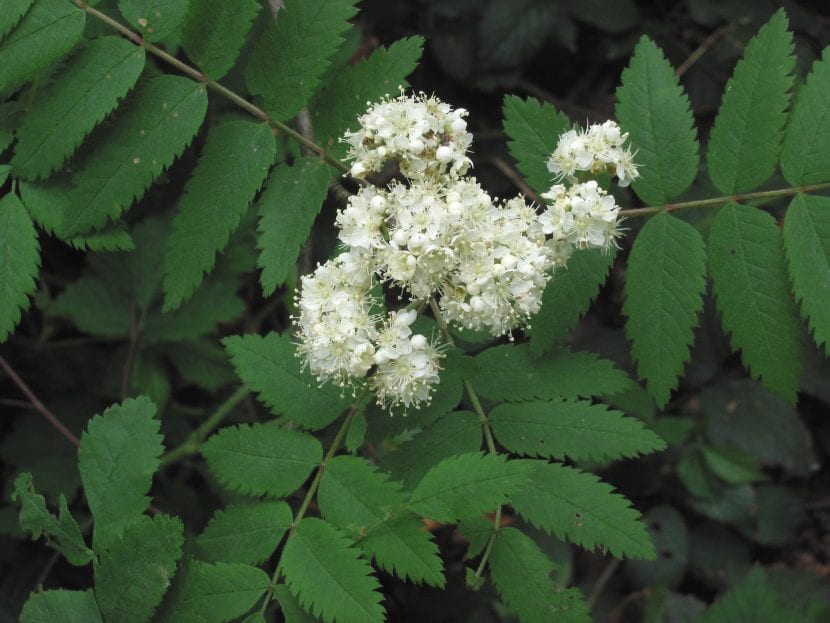
Would you like to have a copy of sorbus aucuparia in your garden? If so, we recommend that you follow these tips:
Location
Being a large tree, You must plant it in the garden, at a minimum distance of 7 meters from any construction and other tall plants. In a pot it can be, but only during the first years. Tolerates both full sun and partial shade.
Soil or substrate
Not demanding, but it grows better in those that do not have lime. It is imperative that you have a good sewer systemOtherwise its roots will rot.
Irrigation
You have to water frequently, especially during periods of drought. As usual, You should water it three or four times in summer and every 5-6 days the rest of the year. Whenever possible, use rainwater or lime-free water, but if you can't get it, fill a bucket and let it sit overnight. This will leave the heavy metals at the bottom, and you can use the water from the top half of the container.
Subscriber
Especially during spring and summer it is very important that you pay it with Organic fertilizers, Such as chicken manure at the first station and guano in the second. In this way, you will not only achieve excellent growth and development, but it will also produce many more fruits that you can taste as soon as they finish ripening, in autumn.
Planting time
The ideal time to plant it in the garden is in spring, as soon as the risk of frost has passed.
Pruning
You can prune it if you see it necessary in the fall or late spring.
Multiplication
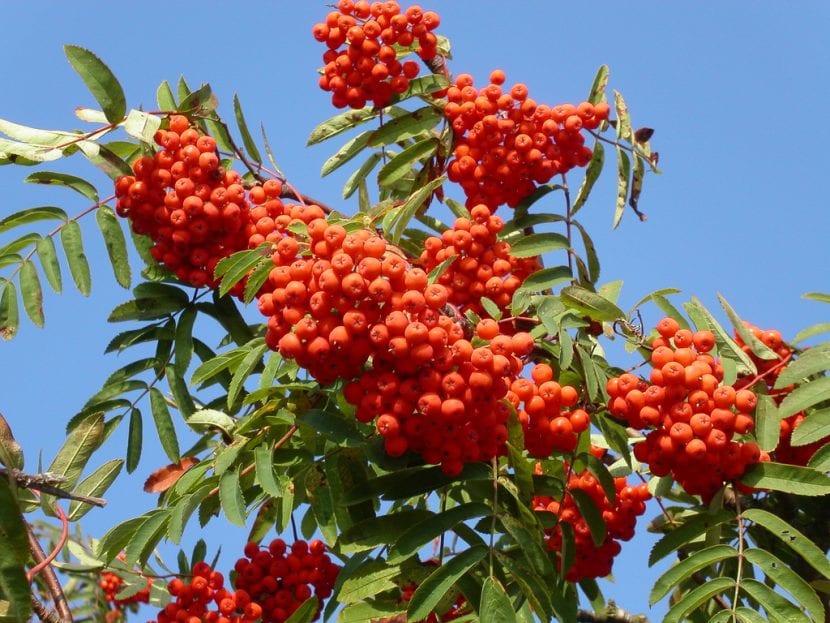
- Seeds: they have to stratify cold for a period of 6 to 8 months. They can take about 1 year to germinate.
- Suckers: you can separate them from the mother plant when they have a manageable height (about 15-20cm).
- Varieties: multiply by grafts.
Plagues and diseases
It is very resistant, but it is sensitive to the attack of the rust fungus and that of the borers. Find out how to act in each case:
- Roya: this disease produced mainly by Puccina and Melampsora fungi, penetrate the plant through the roots or wounds, causing the appearance of small red or brown bumps on the underside of the leaves. You can treat your tree with a synthetic (chemical) fungicide such as Fosetyl-Al, or with Bordeaux mixture in spring, which is natural. See file.
- Borers: they are insects that eat wood while carving galleries under the bark. You can treat it with Fenitrotion or Delmatrin, but if the tree is very weakened it is best to cut it down and burn it. Fortunately, you can prevent them by keeping Sorbus aucuparia well watered and manured.
Rusticity
Withstands cold and frost up to -25ºC. Amazing, right? 😉 However, the tropical and subtropical climate and temperatures of 30ºC or higher do not suit you.
What uses does the Sorbus aucuparia have?
This amazing tree has numerous uses, which are:
- Ornamental: the size it has, the flowers, ... everything is so elegant, that it looks wonderful in medium and large gardens. In addition, and as we mentioned at the beginning, it gives a good shade, which comes in handy especially in summer.
- Culinary: the fruits can be eaten fresh, or you can make jams. They are also used in the manufacture of Russian vodka.
The flowers are used to make soothing drinks. - Turnery: wood is strong and elastic, so it is used to make, for example, the legs of beds, tables, chairs, etc.
And last but not least, having deep roots widely used to support unstable soils in the torrential basins.
Where can you buy it and what is the price?
As with all types of plants, el sorbus aucuparia You can only find it for sale in nurseries and garden stores in those climatic zones where it is known that it can thrive without problems.. For example, living in the south of Mallorca (Balearic Islands) myself, I have many difficulties to achieve it; in fact, I have not found it anywhere yet, but I know that in Galicia they sell it. But today, thanks to the Internet, distances have been shortened, and we can get plants from anywhere in the world. (It must always be done legally, making sure that the species we are interested in have passed both CITES and Customs controls and that they are not in danger of extinction). So if the nurseries in your area do not have it, do not hesitate to look for online stores. You will surely find it there.
What is the price? Well, it depends on the size. A young man of about 20 centimeters can cost you 1 or 2 euros, but a larger one of 1m in height already costs about 20 or 30 euros. depending on where you buy it. If you are not in a hurry, I highly recommend buying a young seedling, as it will be easier for you to adapt; Although if you want to have an already grown specimen, make a garden, do not hesitate and go for one 🙂.
What did you think of the Sorbus acuaria? Did you know him?
